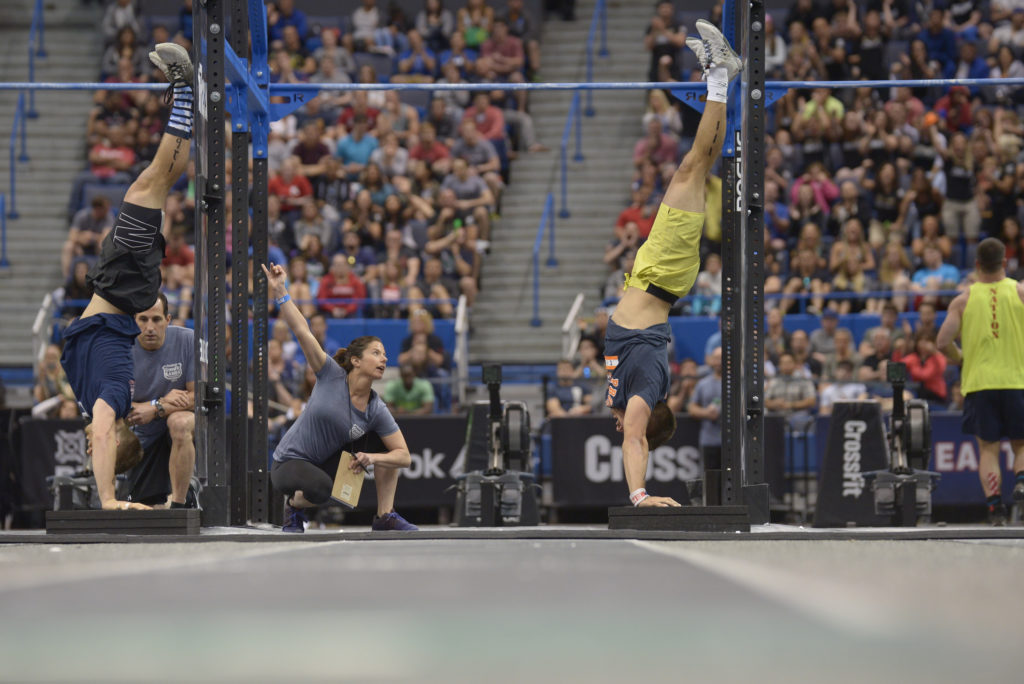Crossfit Programming – How to Program EMOMs

In my opinion, one of the most effective workout formats for improving your fitness is the EMOM, or “Every Minute on the Minute”. The main reason I am advocating for it as the most effective workout format is its versatility. The EMOM, unlike the AMRAP or For Time format, combines the opportunity for an athlete to practice a particular amount of volume on a fixed clock. Effectively, EMOMs can “Frankenstein” the integral parts of both the AMRAP and the For Time format, and gives an athlete the opportunity to use an EMOM for a variety of specific training aims. However, EMOMs can also be used ineffectually, so the goal of this article is to help you perfect your implementation of EMOMs in your training so that you can get more from your efforts. The three versions of EMOMs that I will be discussing below are skill development, volume accumulation, and threshold training.

Skill Development
There will be a movement or movements that will stop you dead in your tracks at some point in your fitness journey. “We fail at the margins of our experience,” which means that until we expose ourselves more regularly to stimuli that challenge us, we can expect a similar outcome until we familiarize ourselves. Commonly, weightlifting and gymnastic movements like strict handstand push ups, squat snatches, or muscle ups are where we see athletes struggle the most. If you find yourself struggling with these movements, EMOMs can be a perfect way to attack them. Early in your practice, you should keep the volume per round extremely modest. An appropriate example of a skill-building EMOM is:
Every Minute for 10 Minutes
1-3 Strict Handstand Push Ups
Or,
Every :45 for 15 Minutes
1 Squat Snatch
The entire purpose of a skill accumulation EMOM is to improve specific movement patterns outside of intensity through repeated efforts. The only intensity that should occur during a skill development EMOM is the focus you bring to the quality of your movement. When performing this style of EMOM, pick one or two things maximum to focus upon improving. If you try to improve everything at once, you’ll improve nothing.

Volume Accumulation
Once you’ve begun to gain confidence in your movement patterns via skill development, it’s now time to “get your reps in.” There is a critical difference between skill development and volume accumulation during EMOMs which is consistency. Until you have mastered the fundamentals of the movement you are looking to improve and you are consistently able to perform the movement with quality, you are better off sticking with skill development EMOMs, rather than volume accumulation EMOMs. If you try to skip ahead, to volume accumulation before mastering the basics, you put the cart before the horse. When you have earned the right to add volume by mastering the basics, you can start to build your confidence in these movements by introducing more demanding and more challenging sessions incrementally. For example:
Week 1
Every Minute for 10 Minutes
8 Toes to Bar
Week 2
Every Minute for 10 Minutes
10 Toes to Bar
Week 3
Every Minute for 10 Minutes
12 Toes to Bar
For a volume accumulation-based EMOM to be most effective, there must be enough time between rounds to allow for enough recovery that the technique does not degrade dramatically. In this version of the EMOM, we are not testing our threshold; we are looking to build volume, so the amount of work mustn’t be prohibitive to the continuation of the EMOM. Typically this means that roughly ¼ -½ of the working window is used to build volume, whereas the rest is used for recovery and reflection. If you find yourself working for longer than you’re resting in an EMOM, there’s a good chance things will break down or turn into Threshold training.

Threshold Training
Now it’s go time. Once you’ve mastered the basics of a skill and you’ve put your reps in, you need to start experimenting with finding your threshold. Unlike the previous two versions where you explicitly avoid a dramatic breakdown in technique, in this version of the EMOM, you are intentionally seeking to find the line where technique begins to falter by adding an a movement that intentionally interferes with the movement you’re trying to train, either through muscular pre-fatigue or metabolic pre-fatigue. Early on, you should err on the side of caution when programming the interfering movement. As you further develop proficiency of executing under fatigue, you can aim to increase the intensity of the interfering exercises.
There are many different ways to implement a threshold style EMOM, but two of the most common are: 1) increasing the volume in the working window so that there isn’t time for sufficient rest, or 2) adding in a secondary movement that is intentionally programmed to interfere with the movement you are trying to improve upon. Examples of interference can be localized muscle fatigue. For example:
Every 2 Minutes for 10 Minutes
10 Push Ups ← Interfering Movement
50’ Handstand Walk ← Skill you are looking to train
Or
Every 2 Minutes for 12 Minutes
12 Chest to Bar Pull Ups ← Interfering Movement
2 Legless Rope Climbs ← Skill you are looking to train
Another way to create intentional interference is by elevating the heart rate. In our sport, the best practice is to develop a skill outside of intensity, but if that is the only way an athlete practices a skill they will be ill-prepared to call upon that skill when tested in competition or training. A few examples of intentional interference via elevated heart rate are:
Every :90 for 9 Minutes
12 Calorie Row ← Interfering Movement
6 Bar Muscle Ups ← Skill you are looking to train
Or
Every 4 Minutes for 20 Minutes
400m Run ← Interfering Movement
20 Pistols ← Skill you are looking to train
You must approach the interfering movement of the EMOM purposefully. You must apply the appropriate dose of intensity in the interfering movement relative to where you are in your journey if you are looking to develop true proficiency. Early in your practice, a Sustain pace is the most appropriate pace to perform the interference movement. However, as you grow, that pace should quicken to a Reach pace, and in some circumstances, a Send pace. Gradual progression is your friend when it comes to threshold training using an EMOM.

When it comes to helping athletes train, just telling them what to do doesn’t cut it for us. We want to give you the how and the why so you can train more effectively. EMOMs are an effective tool, but like any tool, they can be misused. When getting started – and you should read this next part twice: be patient. Jumping ahead before you’re ready is the most surefire way to slow your progress. Choosing the correct tool for the job and patience and consistency is how you turn weaknesses into strengths.
Happy Training
-Sherb
Written by Matt Sherburne



